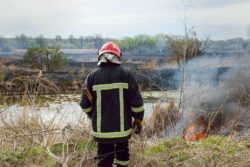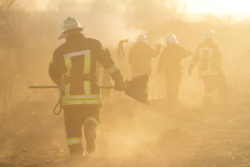
In recent years, the need for firefighting in California has outstripped the California fire budget. This was particularly the case in 2018. Unfortunately, this could put the state in a financial bind if the extreme wildfires continue in future years. To deal with the situation, the state is beginning to turn to creative measures to deal with California wildfires.
How Much Does California Spend Fighting Fires?
In 2018, the state had budgeted $442.8 million for firefighting. However, the state required at least another $234 million to continue fighting fires. With the severity of wildfires, the state was reportedly burning through its allocated funds at a concerning rate. The Sacramento Bee explained that within the first month of the California Department of Forestry and Fire Protection’s fiscal year, which began on July 1, the state had spent $115 million of its $443 million budget, almost a fourth.
The year before, the state spent a whopping $773 million, though only $427 million had been allocated in the year’s California fire budget.
Unfortunately, there isn’t really a good choice that involves not spending the money needed, said the Sacramento Bee. Reportedly, if the situation isn’t appropriately dealt with, fire conditions will get worse in future years, which will take even more resources to combat. Governor Jerry Brown said that the current heat conditions are “uncharted territory,” and will continue to worsen. In August 2020, Death Valley reached 130 degrees, the hottest temperature in over 100 years and the highest temperature ever recorded on Earth reliably.
Commenting on the current and future costs of wildfires, and on the implication for the California fire budget, Governor Brown said, “We’re in for a really rough ride.” He went on to stress that “It’s going to get expensive, it’s going to get dangerous, and we have to apply all our creativity to make the best of what is going to be an increasingly bad situation.”
The federal government has also contributed funds to help fight the wildfires in California. Politifact explains that the U.S. Forest Service spent $73 million helping to fight the Ferguson Fire alone.
Where is the Money Being Spent?
Because recent wildfire seasons have been so severe, experts argue that traditional firefighting tactics won’t be enough. This means that the state will have to spend more money developing better, more extensive solutions to truly deal with the fires.

The new tactics to deal with large fires include geographic features designed to control a fire, so it can’t burn into communities. Other important strategies involve removing dead trees and vegetation that could start fires.
On the flip side, reforestation is used to help the state recover from a fire, and requires funds and effort, explains the U.S. Forest Service. Reforestation is one way that firefighters try to mitigate some of the impact of climate change, and lessen some of the factors that contributed to the wildfires.
However, some California residents and fire experts disagree on how to spend the money allocated for future fire prevention. While most efforts are focusing on brush thinning projects, some people are concerned that thinning the vegetation surrounding communities will do little to save homes from future wildfires.
Is Thinning Enough?
In 2018, the Camp Fire destroyed most of the town of Paradise, displacing thousands of residents and leveling their homes. Reportedly, 85 people died due to the Camp Fire, and around 11,000 homes and buildings were damaged or destroyed.
 According to the Los Angeles Times, Paradise officials had spent years thinning the brush and trees surrounding the city, in an attempt to create a barrier between the woods and the community. However, high wind conditions made it easy for the Camp Fire to leap from the sparse vegetation to the homes and other structures in the town.
According to the Los Angeles Times, Paradise officials had spent years thinning the brush and trees surrounding the city, in an attempt to create a barrier between the woods and the community. However, high wind conditions made it easy for the Camp Fire to leap from the sparse vegetation to the homes and other structures in the town.
Director of the California Chaparral Institute Richard Halsey argues that instead of spending the California fire budget to thin brush, these funds may be better spent shoring up homes and making them more fire resistant. If thinning trees cannot stop fires from spreading, adding ember-proof vents and fire resistant features may make it harder for these blazes to destroy entire communities.
Cal Fire director Thom Porter disagrees with critics, however, stating that while brush thinning around residential areas cannot eliminate future fires, removing these sources of fuel may slow them down before they reach homes and other buildings, giving firefighters time to respond.
Innovative Firefighting and Tech
Wildfire experts explain that the scope and severity of the wildfires means that state officials and firefighters will have to use innovative techniques in order to meet the challenges posed by both the fires themselves and the constraints of the California fire budget.
Happily, Buzz Solutions, a startup company based in Stanford, California has developed new AI technology, that could help the state prevent wildfires before they start. Currently, the technology is in its pilot phase. The company created a way to use artificial intelligence to identify potential risk factors and problems that could start wildfires. This analysis would allow officials and firefighters to address them in advance, hopefully saving lives and property.
Forbes goes into detail about the project, explaining that the technology is able to access the many images of power lines that have been uploaded to the cloud from a range of sources including helicopters, aircrafts, and drones. The new technology uses AI to search these images to identify possible fire risks.
Forbes explains that this is significant, because problems with faulty power lines have been the source of a number of California wildfires in the past. PG&E is still facing lawsuits from past wildfires. Additionally, vegetation can cross power lines and create a fire hazard.
Currently, power companies do try to identify problems with power lines before fires start. However, this is traditionally done through in-person inspection. It is a costly endeavor, and can take months or even years to complete, by which time a fire could have started and ravaged communities. Buzz Solutions’ new technology can analyze potential problems in just hours, for about half of the cost of traditional inspection.
Join a Free California Wildfire Property Damage Lawsuit Investigation
If you or a loved one suffered property damage in the Camp Fire, Woolsey Fire, Hill Fire or last year’s Thomas Fire, legal help is available to help you through the claim process with your insurance company.
This article is not legal advice. It is presented
for informational purposes only.
ATTORNEY ADVERTISING
Top Class Actions is a Proud Member of the American Bar Association
LEGAL INFORMATION IS NOT LEGAL ADVICE
Top Class Actions Legal Statement
©2008 – 2026 Top Class Actions® LLC
Various Trademarks held by their respective owners
This website is not intended for viewing or usage by European Union citizens.
Get Help – It’s Free
Join a Free California Wildfire Property Damage Lawsuit Investigation
If you qualify, an attorney will contact you to discuss the details of your potential case at no charge to you.
PLEASE NOTE: If you want to participate in this investigation, it is imperative that you reply to the law firm if they call or email you. Failing to do so may result in you not getting signed up as a client or getting you dropped as a client.
E-mail any problems with this form to:
[email protected].
Oops! We could not locate your form.












